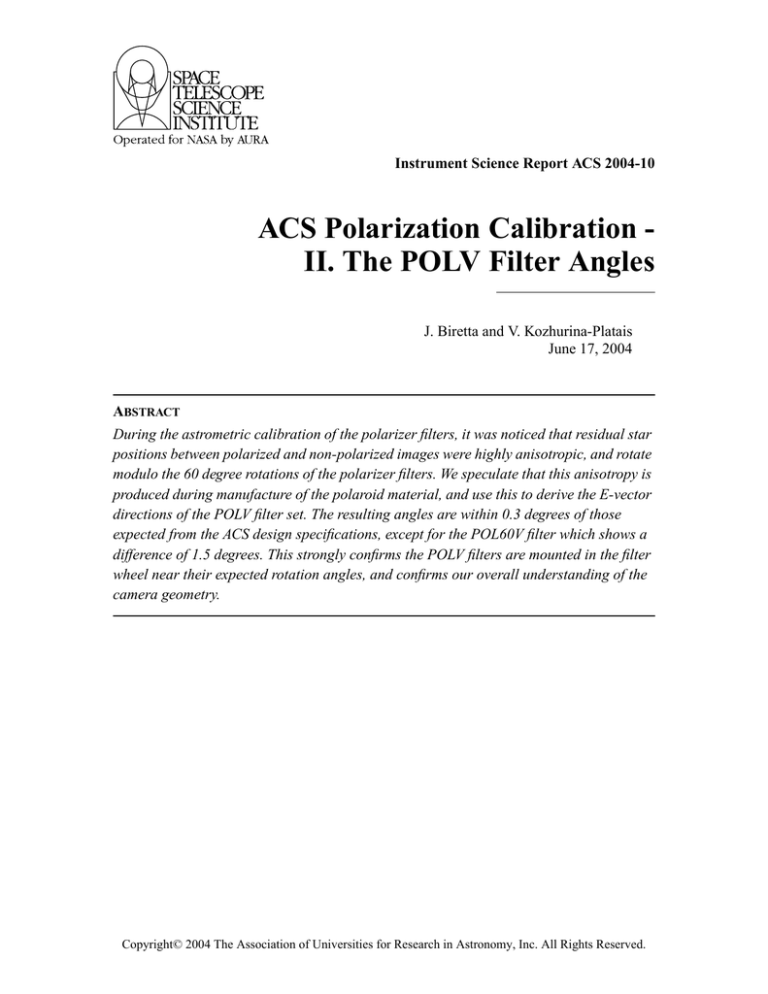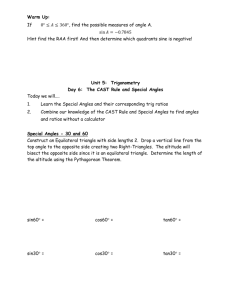
Instrument Science Report ACS 2004-10
ACS Polarization Calibration II. The POLV Filter Angles
J. Biretta and V. Kozhurina-Platais
June 17, 2004
ABSTRACT
During the astrometric calibration of the polarizer filters, it was noticed that residual star
positions between polarized and non-polarized images were highly anisotropic, and rotate
modulo the 60 degree rotations of the polarizer filters. We speculate that this anisotropy is
produced during manufacture of the polaroid material, and use this to derive the E-vector
directions of the POLV filter set. The resulting angles are within 0.3 degrees of those
expected from the ACS design specifications, except for the POL60V filter which shows a
difference of 1.5 degrees. This strongly confirms the POLV filters are mounted in the filter
wheel near their expected rotation angles, and confirms our overall understanding of the
camera geometry.
Copyright© 2004 The Association of Universities for Research in Astronomy, Inc. All Rights Reserved.
Instrument Science Report ACS 2004-10
1. Introduction
The ACS visible polarizer (POLV) filter set contains three polarizers which are mounted
in filter wheel #2 with their E-vectors at nominal 60 degree angles to each other. We have
previously used the ACS design specifications to derive angles on the sky for these filters
(Biretta, et al., 2004). An important aspect of the polarization calibration is to check these
angles, both to verify that the filters were correctly installed in the filter wheel, and to confirm our overall understanding of the camera geometry.
While the angles for the ultraviolet polarizers (POLnUV set, where n=0, 60, and 120)
were confirmed by the RAS/Cal pre-launch test, this same test gave very strange results
for the visible polarizers (POLnV set; Biretta, et al. 2004). For example, the HRC data
indicated the POL0V filter was 6.4 degrees from the design specification angle, while the
WFC data for the same filter indicated it was close to the expected angle. Similar results
were also found for the POL60V filter. In that report we argued these anomalies might be
caused by either polarization effects in the F625W filter used for the test, or by unknown
measurement errors. Unfortunately, this has left us without any solid confirmation of the
POLV filter angles. Herein we derive angles for the POLV filters using a prominent but
unexpected pattern in their distortion solution residuals.
2. Observations and Analyses
Observations of 47 Tuc were made both with and without the polarizer filters in place
using the HRC with the F606W filter (see Biretta, et al., 2004 and Kozhurina-Platais, et
al., 2004 for details). The data without polarizers are from program 9019, and those with
the polarizers are from program 9586. Table 1 lists the datasets used.
Table 1. Datasets and results of angle fits.
Parameter
POL0V
POL60V
Unpolarized image
POL120V
j8bt06nyq_flt.fits through j8bt06o7q_flt.fits
Polarized image
j8gh07b3q_flt
j8gh07b5q_flt
j8gh07b8q_flt
Number of stars used in fit for angle of
maximum distortion residual
18740
19340
19242
Fitted angle from X-axis to direction of
maximum distortion residual (degrees)
110.42 ± 0.11
172.22 ± 0.13
230.57 ± 0.12
The polarizer filters contain a weak positive meniscus lens which compensates for the
extra optical path caused by placing two filters in the beam. The presence of this lens contributes an extra geometric distortion which must be modeled and corrected. During
modeling of the distortion of the POLV polarizer filter set, it was noticed that the fit resid-
2
Instrument Science Report ACS 2004-10
uals contained a strong systematic component which appeared to rotate by the nominal 60
degree angle between the different polarizer filters. Figures 1, 2, and 3 show the residuals
between star positions (x,y) in the HRC+F606W image and positions in the
HRC+F606W+POLnV (n=0, 60, 120) image, after fitting and removing a second order
polynomial distortion model. This second-order polynomial is an effort to correct the
added distortion caused by the weak lens in the polarizer filters. (Prior to this analysis, a
fourth-order distortion correction was applied to all images to correct for the basic HRC
optical distortion. See Kozhurina-Platais, et al., 2004 for further details of the distortion
modeling).
Figure 1: Distortion residuals and angle fit for the POL0V filter. The best fit angle is
110.42 ± 0.11 degrees.
3
Instrument Science Report ACS 2004-10
Figure 2: Distortion residuals and angle fit for the POL60V filter. The best fit angle is
172.22 ± 0.13 degrees.
4
Instrument Science Report ACS 2004-10
Figure 3: Distortion residuals and angle fit for the POL120V filter. The best fit angle is
230.57 ± 0.12 degrees.
We believe these residuals are caused by optical irregularities in the polaroid material
which are produced during the manufacturing process. The HN32 polaroid material is
manufactured by stretching a thin sheet of polyvinyl alcohol, so as to form long chain molecules. The sheet is subsequently treated with iodine, which bonds to sites along the
molecules, thus rendering the molecules slightly conductive. This process forms a sheet
which is conductive in one direction, and hence opaque to light polarized in the stretch
direction, while remaining transparent to light polarized in the perpendicular direction.
While exact details of the manufacture process are not known, we can make some reasonable conjectures. For example, one way to stretch the sheet would be to roll it between
5
Instrument Science Report ACS 2004-10
long pairs of cylindrical rollers rotating at different speeds. In such a process, any irregularities in the speed of the rollers would generate thick and thin ridges in the sheet, and
hence forming long cylindrical lenses wherever the thickness changed. This would thus
cause localized optical distortions which move images in a direction parallel to the stretch,
and hence perpendicular to the transmitted E vector. This direct coupling between the
polarization E-vector and the geometric distortion makes this a powerful diagnostic of the
polarizer angles.
Angles between the X-direction and direction of greatest residual distortion in Figure 1,
Figure 2, and Figure 3 were measured as follows. First the X and Y coordinates for each
data set were rotated clockwise “by eye” so that the direction of maximum residual was
roughly along the X-axis. We then made a simple least-squares fit of a straight line to the
data (i.e. ∆y = a ⋅ ∆x + b ) to produce exact values for the angles. The total rotation is
thus the sum of the large rotation and the smaller fitted angle. Resulting angles are listed in
Table 1. The quoted uncertainties are formal errors from the fitting.
Calculations of the polarizer E-vector directions relative to the spacecraft +V3 direction
are summarized in Table 2. The first ingredient is the angle from the spacecraft V3 direction to the CCD +X direction, which is 84.1 degrees (Table 8.2 in the ACS Instrument
Handbook). Since our fitted angles are measured relative to an undistorted pixel grid, a
second ingredient is the angle from the CCD +X direction (CCD edge between the C and
D amplifiers) to the undistorted X direction. This angle was measured by comparing pixel
coordinates of the CCD edge in “raw” and distortion-corrected images, and found to be 5.99 degrees. After the fitted angle (Figures 1 - 3), the final ingredient is the 90 degree
angle from the direction of maximum residual distortion to the polarizer E-vector.
Table 2. Derivation of HRC polarizer angles using distortion residuals.
Parameter
Angle
(degrees counter-clockwise projected on sky)
POL0V
POL60V
+V3 to HRC +X axis (CCD C-D edge)
-84.1
HRC +X axis to undistorted X direction
-5.99
Undistorted X direction to direction of
maximum distortion residual (from fit)
110.42 ± 0.11
Direction of maximum distortion residual to polarizer E-vector
+V3 to polarizer E-vector
172.22 ± 0.13
POL120V
230.57 ± 0.12
-90
– 69.67 ± 0.11
6
– 7.86 ± 0.13
50.48 ± 0.12
Instrument Science Report ACS 2004-10
3. Results and Discussion
The resulting angles for the POLV filter E-vectors are listed in Table 3 and compared to
angles derived from the ACS design specifications (Biretta, et al., 2004). The angles show
remarkable agreement with the design specification angles. The largest discrepancy is
1.5 ± 1.0 degrees for the POL60V filter. The uncertainties in this comparison are dominated by those on the angles derived from the design specifications, and these
uncertainties are of a systematic nature -- they are effectively an uncertainty in the rotation
of the reference frame used in defining the design specification angles. Hence, the difference for the POL60V filter, especially in light of the excellent agreement for the other
filters, is probably more significant that it might appear at first glance.
Table 3. Comparison of distortion residual results and angles from ACS design specifications.
Source of results
Angle from +V3 to polarizer E-vector
(degrees counter-clockwise projected on sky)
POL0V
POL60V
POL120V
Distortion residuals
– 69.67 ± 0.11
– 7.86 ± 0.13
50.48 ± 0.12
ACS design specifications
– 69.4 ± 1.0
– 9.4 ± 1.0
50.6 ± 1.0
Difference
– 0.3 ± 1.0
1.5 ± 1.0
– 0.1 ± 1.0
This method is susceptible to some systematic errors, but these errors are probably very
small. One potential issue is that the geometric distortion at the polarizer filter is slightly
different from that at the CCD, and hence the fitted angles might suffer some uncompensated distortion. However, any such distortion should not contribute a net rotation of the
field at the field center, and since the stars are more-or-less uniformly distributed around
the HRC detector, the net location sampled is effectively the field center. Problems in the
fitting procedure could potentially produce residuals with some directionality, which
would in turn distort the results in Figures 1 - 3. But this is highly unlikely -- the fitting
functions should easily remove any simple offset between the astrometry results for the
unpolarized and polarized data sets, and the uniform distribution of stars around the HRC
so strongly suppress any bias from higher order terms.
The results herein give strong confirmation that the POLV filters are mounted at the proper
angles in the filter wheel, and confirm our overall understanding of the camera geometry.
The small error for the POL60V is an interesting result that needs further confirmation.
For now, it is perhaps most prudent to use the design specification angles, until such time
as there is further evidence.
7
Instrument Science Report ACS 2004-10
References
Biretta, J., Kozhurina-Platais, V., Boffi, F., Sparks, W., and Walsh, J., 2004, “ACS
Polarization Calibration: I. Introduction and Status Report,” ACS Instrument Science
Report 2004-09
Kozhurina-Platais, V. and Biretta, J., 2004, ACS Instrument Science Report, in
preparation.
Pavlovsky, C., et al., 2003, ACS Instrument Handbook for Cycle 13, v. 4.0.
8





